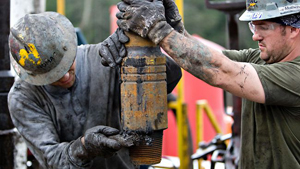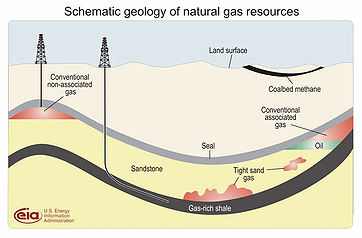"Unconventionals are easy to find but hard to get"
on
Geology Professor Jan de Jager (ex-Shell) puts West European shale gas prospects in perspective
"Unconventionals are easy to find but hard to get"
Don't expect a US-style boom in shale gas production in Western Europe. It's still not proven that economically viable reserves of shale gas even exist over here. Compared with North America, the regions in Europe characterized by the necessary geological conditions for shale gas are scarce. This is the opinion of Jan de Jager, newly appointed professor in Regional and Petroleum Geology at the University of Utrecht, who before his appointment worked as exploration geologist for Shell for over 30 years. In an interview with science journalist Annemieke van Roekel, De Jager notes that unconventional gas tends to be 'easy to find, but hard to produce' - certainly in North Western Europe.
 |
| Exploring for shale gas (photo: The Australian) |
His job at Shell was “global exploration advisor” and “principal expert risk and volume assessment” for unexplored prospects. He was responsible for formulating the guidelines for determining the probability that a drilling would be successful and estimating the volumes that could be found. This meant, in his words, that ‘I had to make sure that all exploration geologists worked in a consistent and correct manner’. His job included setting guidelines for estimating unconventional gas volumes.
Most recently at Shell he led a team of ‘highly experienced and respected people with various backgrounds’ with the task of helping exploration teams worldwide to improve their creativity and trying to find new ways of finding and producing more oil and gas. ‘I lived and worked for Shell on all continents except Antarctica’, he says.
In his new academic post – for which he held his inaugural speech on November 3 – he will initiate research into the composition of sedimentary basins in order to enhance the predictability of petroleum potential in areas where little exploration has yet been carried out. He’s the third Shell Professor for this chair “Regional and Petroleum Geology”.
The production of unconventional gas (and oil) has become one of the key issues in the energy market in recent years after the “shale gas revolution” in the US, which is now being exported to the rest of the world. Shale gas production is increasingly being criticized on environmental grounds, particularly in Western Europe. The French Parliament has even prohibited all unconventional gas production for the time being. In Eastern Europe, on the other hand, the economic benefits of unconventional gas are stressed.
De Jager believes environmental risks of shale gas production are limited (‘no greater than for conventional gas production’). But he doubts whether significant economically viable unconventional gas reserves exist in countries like Sweden, Germany, the Netherlands and England. Annemieke van Roekel spoke with De Jager in his new university office in Amsterdam.
Why are the conditions for shale gas in Europe and the United States so different?
“That’s linked to the composition of the subsurface. Shale is effectively deeply buried clay; and if that clay comprises a high degree of organic matter it could be a layer that contains recoverable reserves of shale gas. The organic material is made up from the remains of plankton – tiny single-cell organisms – deposited on ocean and sea beds millions of years ago. These layers were subsequently buried deep in the earth’s crust. A combination of high pressure and high temperatures results in the formation of oil at a depth of some three kilometres; for gas formation higher temperatures are required and the organic layer must have been buried to a depth of at least four kilometres.
Shale gas tends to only be recoverable once these compacted layers have come to lie somewhat closer to the surface due to movements in the earth’s crust. And it’s precisely this geological sequence of deep burial followed by upward pressure that’s occurred in large parts of the United States. The substrata containsshales that are millions of years old, stretching across the territories of several states, such as the Marcellus Shale in the eastern US. Around 10 million years ago these layers were pushed upwards once more and they now lie some 1.5 kilometres below the earth’s surface, an ideal depth for gas production. Here in the Netherlands it remains to be seen whether the shales with sufficient organic matter have been buried deep enough or been hot enough in the past to actually result in gas generation. What’s more, even if they are, we don’t yet know if they can be developed economically.”
So above all it's the geological history that determines shale gas potential?
“That’s one condition. In the United States shale gas production has been able to really take off because of the freedom afforded to oil cowboys – formally they’re known as independents – to prospect for shale gas. And US landowners also stand to benefit from any fossil fuels found on their land. That
| With such big financial interests, farmers are more likely to say: come and drill my land to bits. The environment quickly takes a back seat |
Another significant difference between the United States and Europe when it comes to shale gas production is population density. In built-up Europe it’s far more difficult to acquire the necessary permits to create a dense network of drilling wells. In the exploration phase, wells need to be drilled every couple of kilometres, but in the production phase the density of the wells is far greater: as much as every couple of hundred metres. You can see these grids on satellite images of the dry, sparsely populated areas in the US where shale gas is produced. It looks terrible and in Western Europe it would be inconceivable. Nowadays drilling technologies exist that are capable of limiting the damage to the landscape, such as deviated (horizontal) drilling of many wells from a single central borehole and subsequently curving the wells to drill horizontally in the gas-bearing rock. Deviated drilling is already quite common in oil and gas exploration and production.”
In your inaugural lecture you emphasized the need for exploration geologists to use their creativity. Would you care to expand on this?
“Using a combination of seismology (the visualisation of deep underground layers using sound waves; editor) and drilling really only yields a limited picture of the substrata. The resolution of seismic images is quite limited, while boreholes constitute little more than local pinpricks. Test drillings during the exploration phase are characterized by intervals of several kilometres, so effectively we know very little about large areas in between the boreholes and are forced to seek recourse to seismic models. On average, the success rate of an exploratory borehole amounts to around 40 percent. As such there’s a 60 percent chance that a test well – the costs of which could run into tens of millions – ends up yielding nothing. But if an exploratory drilling is successful, the costs of any unsuccessful boreholes are more than recouped.
For both conventionals and unconventionals it’s essential to create a clear picture of the deep substructure in the exploratory phase, based on a model that combines both seismic and drilling data. In this way an exploration geologist can point out the potential prospects – structures in the substrata that could result in gas or oil production. If you’re not creative in this process you won’t gain an insight into how oil and gas is trapped in the rock structures, as it were. Sometimes you’ll be proved right; at other times you’ll be way off the mark. That’s all in the game.”
In which geological formations in Western Europe is shale gas being sought?
“Particularly those shales that contain a relatively high proportion of organic material look promising. In the Netherlands you’re looking at shales from the Jurassic and the Carboniferous. In the case of Jurassic shales, the most interesting is the Posidonia Formation, a band of thirty to sixty metres thick dating back 180 million years that lies around three kilometres below the surface in the Netherlands and extends into Germany and France. Exploratory drilling for shale gas in Germany and Sweden has so far been unsuccessful. Currently it’s thought that the Baltic region represents the biggest potential for
| Exploratory drilling for shale gas in Germany and Sweden has so far been unsuccessful. Currently it's thought that the Baltic region represents the biggest potential for recoverable shale gas |
The IEA predicts that the share of unconventional gas in total gas production is set to almost double to 22 percent in the period to 2035, with shale gas accounting for a 9 percent share. So which unconventional sources of gas production are we talking about in the 21st century?
“Given the unprecedented surge in shale gas production in the US at present, those figures don’t surprise me at all. Alongside shale gas, another two unconventials are currently important for gas production: coal bed methane and basin centred gas. Coal bed methane, now being produced in countries such as Australia and China, is the mine gas emanating from coal seams so infamous among mineworkers because of its explosive properties. The Dutch gas field in Groningen results from gas generated fromcoal seams from the 300 million year-old Carboniferous. Those deep coal bands – the source rock – still generate gas. Drilling directly into these bands is viewed as an unconventional source. Gas production is made more difficult because of the relatively thin coal seams, at most a couple of metres, which make drilling a great deal more complex. Gas production from coal seams lying at a depth of more than 1200 metres is generally speaking not possible, because due to the pressure of the layers on top this kind of rock gains plasticity, becoming less porous and permeable.
A third potential source of unconventional gas, basin centred gas, is also known as ‘tight gas’ – a general term for gas in poorly producing reservoir rocks. These reservoir rocks were deposited many millions of years ago in river deltas characterized by a mix of sand, clay and coal layers that -- like the gas-rich shale bands -- have been buried deep beneath the earth’s crust and subsequently forced upwards again closer to the surface. Basin-centred gas has also taken off in the United States; thanks to the continent’s geological make-up this type of gas is present in large quantities across wide areas in the US. Some of the gas from the source rock has migrated to shallower conventional gas structures in porous sand layers, while some has stayed behind in rocks situated close to the source rock with a very low degree of porosity and permeability; that’s the unconventional source. The pores have clogged up due to mineral and clay deposits combined with high temperatures and pressure. In such tight structures the gas is relatively immobile and so requires fracking, which increases costs.”
What do all these unconventionals have in common?
 |
| Geology Professor Jan de Jager: 'When it comes to conventionals, it’s the other way round: difficult to find but easy to produce' |
With conventional sources, the oil or gas has collected in porous reservoir rock, generally sandstone, situated relatively close to the surface. That makes it relatively easy to produce. Conventional gasfields are relatively small with the gas occurring above water-holding reservoir rock. The gas has forced the water out, as it were, and accumulated above the water level: as such there's always a clear contact with water. What's more, the reservoir rock will have been covered with an impermeable seal, so that the gas hasn't been able to escape.
This contrasts with unconventionals such as shale gas, where the gas remains locked within the richly organic, highly impermeable rock in which it was formed, the source rock – or in the case of basin centred gas, in the poorly permeable rock close to the coal seam. There the gas is hidden in minuscule pores, as result of which it is practically or wholly immobile. First space has to be created so the molecules can be mobilized. And that´s exactly what is achieved by fracking: the rock is subjected to pressure by injecting jets of water into it. By adding sand we ensure that the hairline cracks (fracs) created by the water jets can’t close up. The sand effectively acts as a type of wedge, ensuring that the pores remain open.
Generally speaking you could say that unconventionals are easy to find but hard to produce. When it comes to conventionals, it’s the other way round: difficult to find but easy to produce.”
Estimates of Dutch potential shale gas reserves run to thousands of billions of cubic metres. Aren’t those figures inflated?
“High estimates such as these are based on the total volume of gas present in the substrata. Nobody doubts the presence of gas-rich source rock in the Netherlands. But only a fraction of the available gas is technically recoverable in an economically viable way. Together with a fellow geologist, professor Rien Herber, I believe that the Netherlands harbours several tens of billions to at most several hundred billions of cubic metres in recoverable unconventional gas reserves. Based on an annual consumption of 50 billion cubic metres, this amounts to only a few years of national consumption. This of course would still represent an important volume, and I am very supportive of further research into the possibilities for economically viable non-conventional gas production in the Dutch subsurface.”
Despite current production, estimates of potential conventional worldwide oil and gas reserves have remained unchanged. Past estimates were clearly too low. Why are estimates of oil and gas reserves mostly so conservative?
“As a company, you must gauge the recoverable reserves based on the technology available at that time. According to New York Stock Exchange regulations, proven reserves are those reserves that can be produced profitably in the prevailing economic conditions on the basis of existing technology. Advances in technology over the last few decades have boosted our ability to operate in areas where oil
| Proven reserves are those reserves that can be produced profitably in the prevailing economic conditions on the basis of existing technology |
It looks like the general public has difficulty with these advances in technology. How do you view the public concern that has led to projects being halted in some West European countries and even a moratorium on shale gas production?
“Public concern is mainly targeted at fracking techniques, and I believe it’s an exaggerated response. Hydraulic fracturing is a proven technology that’s been used for several decades in conventional production to boost yields. Fracking in shale requires more water and more pressure, but to my mind that doesn’t increase the safety risk. In England minor tremors have been reported, but these didn’t exceed 2 on the Richter scale. You can’t feel tremors like that, but they can be measured.
The increased pressures placed on regions where non-conventional gas is produced does however constitute cause for concern, in my view. The production of shale gas requires a high incidence of drilling. This could place a strain on a rural environment due to traffic nuisance caused by the tank lorries delivering the water required for the fracking. That nuisance carries on into the production phase which calls for renewed fracking at regular intervals when the field’s production yields decline. The drilling itself occasions only a temporary nuisance: the drill towers defacing the skyline are only kept in place for the actual drilling and the production facilities are far lower and smaller in size. In addition you can limit the environmental impact by drilling several boreholes horizontally from a single location.”
Alongside safety risks, critics moot environmental concerns such as contamination of ground water. Are those concerns also unfounded?
 |
| Schematic geology of natural gas resources (source: EIA) |
Translation: Niall Martin, nmartin@xs4all.nl


Discussion (0 comments)